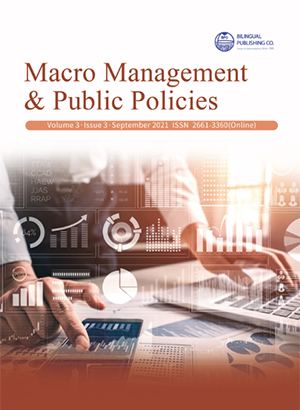-
940
-
350
-
270
-
259
-
237
Financial Inclusion in Nigeria: A Gender Gap Approach
DOI:
https://doi.org/10.30564/mmpp.v3i3.3546Abstract
Ability to have access and use financial goods and services such as bank and mobile money accounts indicates the overall financial inclusion level of an economy and the higher the indices are in any economy, the better that economy is. Financial inclusion is important to realize inclusive growth in any country. It has direct impacts on the level of growth and development experienced by any economy. It can however, be skewed along gender lines as noticed overtime in the Nigerian economy and other developing economies. This study examined financial inclusion in Nigeria: a gender gap approach. It also determined the factors responsible for the gender gaps. The Global Findex (2014) dataset of Nigeria from World Bank database was used to analyse the aims of the study. In the study, 61% of the men were financially included, while only 43% of the female were financially included, with 18% gap. The gap in endowments accounted for the huge difference of the gap in outcomes as males seemed to be more naturally favoured by society than females. The level of education, wealth quintile, saved in past 12 months for farm/business purposes, sent domestic remittances in the past 12 months, paid utility bills in the past 12 months, and received wage payments in the past 12 months are the factors explaining the gender gaps in Nigeria. Thus the government and other relevant stakeholders should encourage females along these factors.
Keywords:
Female; Male; Gender gap; NigeriaReferences
[1] Ajide, K. B. (2014). Determinants of foreign direct investment in ECOWAS. The Empirical Econometrics and Quantitative Economics Letters, 3(2), 51-74.
[2] Beck, T., Behr, P., & Madestam, A. (2011). Sex and credit: Is there a gender bias in lending? European Banking Center Discussion Paper, (2011-027).
[3] Presbitero, A. F., Rabellotti, R., and Piras, C. (2014). Barking up the Wrong Tree? Measuring Gender Gaps in Firm’s Access to Finance. The Journal of Development Studies, 50(10), 1430-1444.
[4] Henderson, L., Herring, C., Horton, H. D., & Thomas, M. (2015). Credit Where Credit is Due? Race, Gender, and Discrimination in the Credit Scores of Business Startups. The Review of Black Political Economy, 42(4), 459-479.
[5] Karlan, D., and Zinman, J. (2010). Expanding credit access: using randomised supply decisions to estimate the impacts. Review of Financial Studies, 23(1), 433-464.
[6] Demirguc-kunt, A., and Klapper, L. (2013). Measruring financial inclusion: explaining variation in use of financial services across and within countries. Brookings Papers on Economic Activity, Spring 2013, 279-340.
[7] Dupas, P., and Robinson, J. (2013). Savings Constraints and Microenterprise Development: Evidence from a Field Experiment in Kenya. American Economic Journal: Applied Economics 5(1), 163-192.
[8] Karpowicz, I. (2014). Financial Inclusion, Gowth and Inequality: A Model Application to Colombia. Washington, DC: International Monetary Fund.
[9] Chiapa, C., Prina, S., & Parker, A. (2016). The effects of financial inclusion on children’s schooling, and parental aspirations and expectations. Journal of International Development, 28, 683-696. DOI: https://doi.org/10.1002/jid.3137
[10] Duflo, E. (2009). Women empowerment and economic development. Journal of Economic Literature, 50(4), 1051-1079. DOI: https://doi.org/10.1257/jel.50.4.1051
[11] Prina, S. (2013). Banking the poor via saving accounts : Evidence from a field experment. Journal of Development Economics, 115, 16-31.
[12] Demirguc-Kunt, A., Klapper, L., Singer, D., and P. V. Ouheusden (2015). The global findex database 2014: Measuring financial inclusion around the world. Policy Research Working paper 7255. World Bank Group.
[13] World Bank. (2012). Women, business and the law: Removing barriers to economic inclusion - Measuring gender parity in 141 economies. Washington, DC: The International Bank for Reconstruction and Development/The World Bank. Retrieved from http://wbl.worldbank.org/reports
[14] Aduda, J., and E. Kalunda (2012). Financial inclusion and financial sector stability with reference to Kenya: A review of literature .Journal of Applied Finance and Banking, 2 (6), 95-120. ISSN: 1792-6580 (print version), 1792-6599 (online).
[15] Arora, R. (2010). “Measuring Financial Access”. Griffith University, Discussion Paper Economics 7, ISSN1837-7750.
[16] Gupte, R. , Venkataramani, B. , & Gupta, D. (2012). “Computation of financial inclusion index for India”. International Journal of Procedia - Social and Behavioral Sciences, 37, 133-149.
[17] Nandru, P. , Anand, B. , & Rentala, S. (2015). Factors influencing financial inclusion through banking services. Journal of Contemporary Research in Management, 10(4), 17-30.
[18] Allen, F. Demirgüç-Kunt, A., Klapper, L. and Martinez Peria, M. S. (2012). “The Foundations of FI. Understanding Ownership and Use of Formal Accounts”. The World Bank. Development Research Group. Finance and Private Sector Development Team. Policy Research Working Paper 6290, World Bank, Washington, DC.
[19] Kholi, N. (2013). “Financial Inclusion & its Impact on Banking Sector in India”. Tecnia Journal of Management Studies, 7(2).
[20] Efobi, U. , Beecroft, I & Osabuohien, E (2014). “Access to and use of bank services in Nigeria: Micro-econometric evidence”. Review of development finance, 4, 104-114.
[21] Jann, B(2008). The Blinder-Oaxaca decomposition for linear regression models.The Stata Journal 8(4), 453-479.
[22] Oaxaca, R. L., 2007. The challenge of measuring labor market discrimination against women. Swedish Economic Policy Review. 14(1), 199.
[23] Pindyck, S. R., & Rubinfeld, L. D. (1998). Econometric Models and Economic Forecasts 4th Edition. New York: McGraw-Hill.
[24] Greene, W. H. (2008). Econometric Analysis. 6th ed. Upper Saddle River, NJ: Prentice Hall.
[25] Alliance for Financial Inclusion (AFI) as contained in the Policy Frameworks to Support Women’s Financial Inclusion (March, 2016 report).
[26] Karlan, D. and J. Morduch. 2009. “Access to Finance.” In Handbook of Development Economics, vol. 5, edited by D. Rodrik and M. Rosenzweig, 4703-84. Elsevier.
[27] Global Findex Database 2014: measuring financial inclusion around the world. World Bank Policy Research Working Paper, (7255).
Downloads
How to Cite
Issue
Article Type
License
Copyright © 2021 Author(s)

This is an open access article under the Creative Commons Attribution-NonCommercial 4.0 International (CC BY-NC 4.0) License.




 Wagbafor Marx O.
Wagbafor Marx O.

